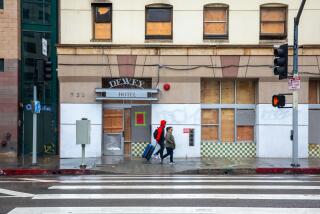Tell us why this homelessness plan will work when the others failed
News flash: The Los Angeles County Board of Supervisors allocated $100 million to fight homelessness and came up with plans to make sure that inmates leaving prison and patients leaving hospitals don’t end up on skid row. Joining with L.A.’s mayor, they called a news conference to announce that this time, finally, they really meant it: They would end homelessness. They had the money, the will and the momentum to succeed where their predecessors had failed.
And they acknowledged that they had better not blow it this time, as they had done so many times before. One supervisor told The Times that he and other elected officials had “an opportunity that will not pass our way again in our political lifetimes.”
What’s missing so far is any indication from the five county supervisors that they grasp just what hazards drove the previous efforts off the road.
And he was right. The county allocated that money and crafted those plans, and Supervisor Zev Yaroslavsky made that statement, in 2006. And when they blew it, the opportunity was gone for the rest of their political lifetimes. Yaroslavsky and two of his colleagues on the Board of Supervisors are gone, and the remaining two will be gone before the end of this year. Then-Mayor Antonio Villaraigosa is gone.
Most of them had signed on to a movement called Bring L.A. Home and an accompanying 10-year comprehensive plan to end homelessness in the region. It included all the up-to-date features, including benchmarks and accountability measures.
But the county instead did what the county often does: It chopped the problem and the solution into five bits, so that each supervisor could run his or her own homelessness program, each with little regard to what the others were doing in their districts. They came up with some innovative ideas. But they did nothing to end the mill of misery that puts so many people on the streets of L.A.
In the ensuing 10 years, some people were housed, some died on the streets and many are still homeless.
So today, when the supervisors are again allocating $100 million to combat homelessness and have again formulated programs to ensure that people leaving hospitals, jails, prisons, foster care, domestic violence shelters and other institutions are not simply released to the streets, and when the mayor and members of the City Council stand up and claim that they are about to declare a homelessness emergency, and when they say that this time, finally, they really mean it, they need to hear this message:
Los Angeles can see you coming.
This is not cynicism, apathy, despair or antigovernment rancor. It is experience.
Any program to reduce or end homelessness and to prevent the societal and governmental malfunctions and personal crises that cause it must rely at some point on buy-in from the region’s voters, taxpayers and neighbors — and they won’t buy in without a persuasive argument from elected leaders that things truly are different this time. They need to be convinced that this year’s plan is better and has a clearer shot at success than the one from a decade ago or all the various plans that have been floated since.
And here’s the thing: Having followed the county’s Homeless Initiative process since officials began working on it last August, and having read the county’s draft and listened to service providers weigh in with their thoughts and critiques, I really do think they may be on to something — something different, workable and, just possibly, successful.
What’s missing so far is any indication from the five county supervisors that they grasp just what hazards drove the previous efforts off the road. If they can’t show that understanding, if they can’t demonstrate that they have learned from their predecessors’ experience, they can’t present a reliable road map for success. And if they can’t do that, Angelenos won’t follow.
The arguments so far fall short.
It’s a matter of superior leadership and political will? Not good enough. Current county leaders may be able to convince themselves that they have stronger backbones and deeper commitments than their predecessors, but that amounts to little more than cockiness. The problem is not that the last board didn’t want it badly enough. They ran into roadblocks. So, current supervisors, what were they? And how will you circumvent them this time?
It’s a question of sustained attention? Then we’re doomed. By nature of their portfolio, county supervisors necessarily lurch from one crisis to another, and their attention can be diverted in an instant when, for example, a child dies of abuse despite warnings to county social workers, or sheriff’s deputies beat a jail inmate without good cause. And how much focus on homelessness plans can be expected after a terrorist attack or a major earthquake? Success requires a system that stays on track even when the attention of supervisors — or the news media — moves elsewhere.
The problem is too big to ignore this time? Hardly. The leaders and the people of this county have ignored worse homelessness crises. The population living on the street is less than half the 90,000 that were there a decade ago. Besides, if the key to solving the problem is scale, it will never be solved. Isn’t that why we are where we are today? A bit of success, instead of breeding more success, diminishes the problem to a level at which we feel entitled to ignore it, until it again blows up.
There are real reasons why things might be different this time. Some will be set forth in this space in the coming weeks. But it would be nice if the supervisors, who will drive their plan to success or failure, could show that they already know what those reasons are.
Follow me @RGreene2
More to Read
A cure for the common opinion
Get thought-provoking perspectives with our weekly newsletter.
You may occasionally receive promotional content from the Los Angeles Times.







